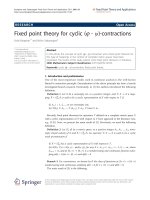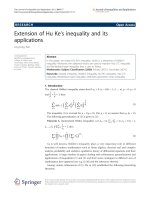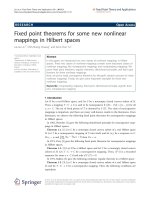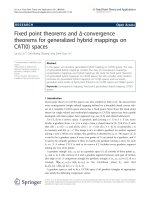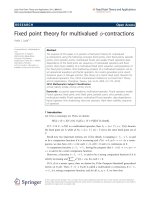Báo cáo hóa học: " FIXED POINT THEORY ON EXTENSION-TYPE SPACES AND ESSENTIAL MAPS ON TOPOLOGICAL SPACES" ppt
Bạn đang xem bản rút gọn của tài liệu. Xem và tải ngay bản đầy đủ của tài liệu tại đây (520.29 KB, 8 trang )
FIXED POINT THEORY ON EXTENSION-TYPE SPACES
AND ESSENTIAL MAPS ON TOPOLOGICAL SPACES
DONAL O’REGAN
Received 19 November 2003
We present several new fixed point results for admissible self-maps in extension-type
spaces. We also discuss a continuation-type theorem for maps between topological spaces.
1. Introduction
In Section 2, we begin by presenting most of the up-to-date results in the literature [3,
5, 6, 7, 8, 12] concerning fixed point theory in extension-type spaces. These results are
then used to obtain a number of new fixed point theorems, one concerning approximate
neighborhood extension spaces and another concerning inward-type maps in extension-
type spaces. Our first result was motivated by ideas in [12] whereas the second result is
based on an argument of Ben-El-Mechaiekh and Kryszewski [9]. Also in Section 2 we
present a new continuation theorem for maps defined between Hausdorff topological
spaces, and our theorem improves results in [3].
For the remainder of this section we present some definitions and known results which
will be needed throughout this paper. Suppose X and Y are topological spaces. Given a
class ᐄ of maps, ᐄ(X,Y ) denotes the set of maps F : X
→ 2
Y
(nonempty subsets of Y)
belonging to ᐄ,andᐄ
c
the set of finite compositions of maps in ᐄ.Welet
Ᏺ(ᐄ) =
Z :FixF =∅∀F ∈ ᐄ(Z, Z)
, (1.1)
where FixF denotes the set of fixed points of F.
The class Ꮽ of maps is defined by the following properties:
(i) Ꮽ contains the class Ꮿ of single-valued continuous functions;
(ii) each F
∈ Ꮽ
c
is upper semicontinuous and closed valued;
(iii) B
n
∈ Ᏺ(Ꮽ
c
)foralln ∈{1,2, };hereB
n
={x ∈ R
n
: x≤1}.
Remark 1.1. The class Ꮽ is essentially due to Ben-El-Mechaiekh and Deguire [7]. It in-
cludes the class of maps ᐁ of Park (ᐁ is the class of maps defined by (i), (iii), and (iv) each
F
∈ ᐁ
c
is upper semicontinuous and compact valued). Thus if each F ∈ Ꮽ
c
is compact
Copyright © 2004 Hindawi Publishing Corporation
Fixed Point Theory and Applications 2004:1 (2004) 13–20
2000 Mathematics Subject Classification: 47H10
URL: />14 Fixed point theorems
valued, the classes Ꮽ and ᐁ coincide and this is what occurs in Section 2 since our maps
will be compact.
The following result can be found in [7, Proposition 2.2] (see also [11, page 286] for a
special case).
Theorem 1.2. The Hilber t cube I
∞
(subset of l
2
consisting of points (x
1
,x
2
, ) with |x
i
|≤
1/2
i
for all i)andtheTychonoff cube T (Cartesian product of copies of the unit interval) are
in Ᏺ(Ꮽ
c
).
We next consider the class ᐁ
κ
c
(X,Y)(resp.,Ꮽ
κ
c
(X,Y)) of maps F : X → 2
Y
such that
for each F and each nonempty compact subset K of X, there exists a map G ∈ ᐁ
c
(K,Y)
(resp., G ∈ Ꮽ
c
(K,Y)) such that G(x) ⊆ F(x)forallx ∈ K.
Theorem 1.3. The Hilbert cube I
∞
and the Tychonoff cube T are in Ᏺ(Ꮽ
κ
c
) (resp., Ᏺ(ᐁ
κ
c
)).
Proof. Let F ∈ Ꮽ
κ
c
(I
∞
,I
∞
). We must show that Fix F =∅. Now, by definition, there exists
G ∈ Ꮽ
c
(I
∞
,I
∞
)withG(x) ⊆ F(x)forallx ∈ I
∞
,soTheorem 1.2 guarantees that there
exists x ∈ I
∞
with x ∈ Gx.Inparticular,x ∈ Fx so FixF =∅.ThusI
∞
∈ Ᏺ(Ꮽ
κ
c
).
Notice that ᐁ
κ
c
is closed under compositions. To see this, let X, Y,andZ be topological
spaces, F
1
∈ ᐁ
κ
c
(X,Y), F
2
∈ ᐁ
κ
c
(Y, Z), and K a nonempty compact subset of X.Now
there exists G
1
∈ ᐁ
c
(K,Y)withG
1
(x) ⊆ F
1
(x)forallx ∈ K.Also[4, page 464] guarantees
that G
1
(K) is compact so there exists G
2
∈ ᐁ
κ
c
(G
1
(K),Z)withG
2
(y) ⊆ F
2
(y)forally ∈
G
1
(K). As a result,
G
2
G
1
(x) ⊆ F
2
G
1
(x) ⊆ F
2
F
1
(x) ∀x ∈ K (1.2)
and G
2
G
1
∈ ᐁ
c
(X,Z).
For a subset K of a topological space X, we denote by Cov
X
(K) the set of all coverings
of K by open sets of X (usually we write Cov(K) = Cov
X
(K)). Given a map F : X →
2
X
and α ∈ Cov(X), a point x ∈ X is said to be an α-fixed point of F if there exists a
member U ∈ α such that x ∈ U and F(x) ∩ U =∅.GiventwomapsF,G : X → 2
Y
and
α ∈ Cov(Y), F and G are said to be α-close if for any x ∈ X there exists U
x
∈ α, y ∈
F(x) ∩ U
x
,andw ∈ G(x) ∩ U
x
.
The following results can be found in [5, Lemmas 1.2 and 4.7].
Theorem 1.4. Let X be a regular topological space and F : X
→ 2
X
an upper semicontinuous
map with closed values. Suppose there exists a cofinal family of coverings θ ⊆ Cov
X
(F(X))
such that F has an α-fixed point for every α ∈ θ. Then F has a fixed point.
Theorem 1.5. Let T be a Tychonoff cube contained in a Hausdorff topological vector space.
Then T is a retract of span(T).
Remark 1.6. From Theorem 1.4 in proving the existence of fixed points in uniform spaces
for upper semicontinuous compact maps with closed values, it suffices [ 6, page 298] to
prove the existence of approximate fixed points (since open covers of a compact set A
Donal O’Regan 15
admit refinements of the form {U[x]:x ∈ A} where U is a member of the uniformity
[14, page 199], so such refinements form a cofinal family of open covers). Note also that
uniform spaces are regular (in fact completely regular) [10, page 431] (see also [10,page
434]). Note in Theorem 1.4 if F is compact valued, then the assumption that X is regular
can be removed. For convenience in this paper we will apply Theorem 1.4 only when the
space is uniform.
2. Extension-type spaces
We begin this section by recalling some results we established in [3]. By a space we mean
a Hausdorff topological space. Let Q be a class of topological spaces. A space Y is an
extension space for Q (written Y ∈ ES(Q)) if for all X ∈ Q and all K ⊆ X cl osed in X,any
continuous function f
0
: K → Y extends to a continuous function f : X → Y.
Using (i) the fact that every compact space is homeomorphic to a closed subset of the
Tychonoff cube and (ii) Theorem 1.3, we established the following result in [3].
Theorem 2.1. Let X ∈ ES(compact) and F ∈ ᐁ
κ
c
(X,X) a compact map. Then F has a fixed
point.
Remark 2.2. If X
∈ AR (an absolute retract as defined in [11]), then of course X ∈
ES(compact).
AspaceY is an approximate e xtension space for Q (written Y ∈ AES(Q)) if for all
α ∈ Cov(Y), all X ∈ Q,allK ⊆ X closed in X, and any continuous function f
0
: K → Y,
there exists a continuous function f : X → Y such that f |
K
is α-close to f
0
.
Theorem 2.3. Let X ∈ AES(compact) be a uniform space and F ∈ ᐁ
κ
c
(X,X) acompact
upper semicontinuous map with closed values. Then F has a fixed point.
Remark 2.4. This result was established in [3]. H owever, we excluded some assumptions
(X uniform and F upper semicontinuous with closed values) so the proof in [3]hastobe
adjusted slightly.
Proof. Let α ∈ Cov
X
(K)whereK = F(X). From Theorem 1.4 (see Remark 1.6), it suffices
to show that F has an α-fixed point. We know (see [13]) that K can be embedded as
a closed subset K
∗
of T;lets : K → K
∗
be a homeomorphism. Also let i : K X and
j : K
∗
T be inclusions. Next let α
= α ∪{X\K} and note that α
is an open covering of
X. Let the continuous map h : T → X be such that h|
K
∗
and s
−1
are α
-close (guaranteed
since X ∈ AES(compact)). Then it follows immediately from the definition (note that
α
= α ∪{X\K})thaths : K → X and i : K → X are α-close. Let G = jsFh and notice
that G ∈ ᐁ
κ
c
(T,T). Now Theorem 1.3 guarantees that there exists x ∈ T with x ∈ Gx.
Let y = h(x), and so, from the above, we have y ∈ hjsF(y), that is, y = hjs(q)forsome
q ∈ F(y). Now since hs and i are α-close, there exists U ∈ α with hs(q) ∈ U and i(q) ∈ U,
that is, q ∈ U and y = hjs(q) = hs(q) ∈ U since s(q) ∈ K
∗
.Thusq ∈ U and y ∈ U,so
y ∈ U and F(y) ∩ U =∅since q ∈ F(y). As a result, F has an α-fixed point.
Definit ion 2.5. Let V be a uniform space. Then V is Schauder admissible if for every com-
pact subset K of V and every covering α ∈ Cov
V
(K), there exists a continuous function
(called the Schauder projection) π
α
: K → V such that
16 Fixed point theorems
(i) π
α
and i : K V are α-close;
(ii) π
α
(K) is contained in a subset C ⊆ V with C ∈ AES(compact).
Theorem 2.6. Let V be a uniform space and Schauder admissible and F ∈ ᐁ
κ
c
(V, V) a
compact uppe r semicontinuous map with closed values. The n F has a fixed point.
Proof. Let K = F(X)andletα ∈ Cov
V
(K). From Theorem 1.4 (see Remark 1.6), it suf-
fices to show that F has an α-fixed point. There exists π
α
: K → V (as described in Defini-
tion 2.5)andasubsetC ⊆ V with C ∈ AES(compact) such that (here F
α
= π
α
F)
F
α
(V) = π
α
F(V) ⊆ C. (2.1)
Notice that F
α
∈ ᐁ
κ
c
(C,C) is a compact upper semicontinuous map with closed (in fact
compact) values. So Theorem 2.3 guarantees that there exists x ∈ C with x ∈ π
α
F(x), that
is, x = π
α
q for some q ∈ F(x). Now Definition 2.5(i) guarantees that there exists U ∈ α
with π
α
(q) ∈ U and i(q) ∈ U, that is, x ∈ U and q ∈ U.Thusx ∈ U and F(x) ∩ U =∅
since q ∈ F(x), so F has an α-fixed point.
AspaceY is a ne ighborhood extension space for Q (wr itten Y ∈ NES(Q)) if for all
X ∈ Q,allK ⊆ X closed in X, and any continuous function f
0
: K → Y, there exists a
continuous extension f : U → Y of f
0
over a neighborhood U of K in X.
Let X ∈ NES(Q)andF ∈ ᐁ
κ
c
(X,X) a compact map. Now let K, K
∗
, s,andi be as in
the proof of Theorem 2.3.LetU be an open neighborhood of K
∗
in T and let h
U
: U → X
be a continuous extension of is
−1
: K
∗
→ X on U (guaranteed since X ∈ NES(compact)).
Let j
U
: K
∗
U be the natural embedding, so h
U
j
U
= is
−1
. Now consider span(T)ina
Hausdorff locally convex topological vector space containing T.NowTheorem 1.5 guar-
antees that there exists a retraction r :span(T) → T.Leti
∗
: U r
−1
(U)beaninclusion
and consider G = i
∗
j
U
sFh
U
r. Notice that G ∈ ᐁ
κ
c
(r
−1
(U),r
−1
(U)). We now assume that
G ∈ ᐁ
κ
c
r
−1
(U),r
−1
(U)
has a fixed point. (2.2)
Now there exists x ∈ r
−1
(U)withx ∈ Gx.Lety = h
U
r(x), so y ∈ h
U
ri
∗
j
U
sF(y), that is,
y = h
U
ri
∗
j
U
s(q)forsomeq ∈ F(y). Since h
U
(z) = is
−1
(z)forz ∈ K
∗
,wehave
h
U
ri
∗
j
U
s(q) =
h
U
ri
∗
j
U
s(q) = i(q), (2.3)
so y ∈ F(y).
Theorem 2.7. Let X ∈ NES(compact) and F ∈ ᐁ
κ
c
(X,X) acompactmap.Alsoassumethat
(2.2)holdswithK, K
∗
, s, i, i
∗
, j
U
, h
U
,andr as described above. Then F has a fixed point.
Remark 2.8. Theorem 2.7 was also established in [3]. Note that if F is admissible in the
sense of Gorniewicz and the Lefschetz set Λ(F) ={0},thenweknow[11]that(2.2)holds.
Note that if X ∈ ANR (see [11]), then of course X ∈ NES(compact).
AspaceY is an approximate neighborhood extension space for Q (written Y ∈ANES(Q))
if for all α ∈ Cov(Y ), all X ∈ Q,allK ⊆ X closed in X, and any continuous function f
0
:
K → Y, there exists a neighborhood U
α
of K in X and a continuous function f
α
: U
α
→ Y
such that f
α
|
K
and f
0
are α.
Donal O’Regan 17
Let X ∈ ANES(compact) be a uniform space and F ∈ ᐁ
κ
c
(X,X) a compact upper semi-
continuous map with closed values. Also let α ∈ Cov
X
(K)whereK = F(X). To show that
F has a fixed point, it suffices (Theorem 1.4 and Remark 1.6) to show that F has an α-fixed
point. Let α
= α ∪{X\K} and let K
∗
, s,andi be as in the proof of Theorem 2.3.Since
X ∈ ANES(compact), there exists an open neighborhood U
α
of K
∗
in T and f
α
: U
α
→ X
a continuous function such that f
α
|
K
∗
and s
−1
are α
-close and as a result f
α
s : K → X and
i : K → X are α-close. Let j
U
α
: K
∗
U
α
be the natural imbedding. We know (see [5,page
426]) that U
α
∈ NES(compact). Also notice that G
α
= j
U
α
sF f
α
∈ ᐁ
κ
c
(U
α
,U
α
)isacompact
upper semicontinuous map with closed values. We now assume that
G
α
= j
U
α
sF f
α
∈ ᐁ
κ
c
U
α
,U
α
has a fixed point for each α ∈ Cov
X
F(X)
. (2.4)
We still have α ∈ Cov
X
(K)fixedandweletx be a fixed point of G
α
.Nowlety
α
= f
α
(x),
so y = f
α
j
U
α
sF(y), that is, y = f
α
j
U
α
s(q)forsomeq ∈ F(y). Now since f
α
s and i are α-
close, there exists U ∈ α with f
α
s(q) ∈ U and i(q) ∈ U, that is, q ∈ U and y = f
α
j
U
α
s(q) =
f
α
s(q) ∈ U since s(q) ∈ K
∗
.Thusq ∈ U and y ∈ U,so
y ∈ U, F(y) ∩U =∅ since q ∈ F(y). (2.5)
Theorem 2.9. Let X ∈ ANES(compact) be a uniform space and F ∈ ᐁ
κ
c
(X,X) acompact
upper se micontinuous map with closed values. Also assume that (2.4)holdswithK, s, U
α
,
j
U
α
,and f
α
as des cribed above. Then F has a fixed point.
Next we present continuation results for multimaps. Let Y be a completely regular
topological space and U an open subset of Y . We consider a subclass Ᏸ of ᐁ
κ
c
. This sub-
class must have the following property: for subsets X
1
, X
2
,andX
3
of Hausdorff topologi-
cal spaces, if F ∈ Ᏸ(X
2
,X
3
)iscompactand f ∈ Ꮿ(X
1
,X
2
), then F ◦ f ∈ Ᏸ(X
1
,X
3
).
Definit ion 2.10. The map F ∈ Ᏸ
∂U
(U,Y)ifF ∈ Ᏸ(U,Y)withF co mpact and x/∈ Fx for
x ∈ ∂U;hereU (resp., ∂U) denotes the closure (resp., the boundary) of U in Y.
Definit ion 2.11. AmapF ∈Ᏸ
∂U
(U,Y) is essential in Ᏸ
∂U
(U,Y)ifforeveryG∈Ᏸ
∂U
(U,Y)
with G|
∂U
= F|
∂U
, there exists x ∈ U with x ∈ Gx.
Theorem 2.12 (homotopy invariance). Le t Y and U be as above. Suppose F ∈ Ᏸ
∂U
(U,Y)
is essential in Ᏸ
∂U
(U,Y) and H ∈ Ᏸ(U × [0, 1],Y) is a c losed compact map with H(x,0) =
F(x) for x ∈ U.Alsoassumethat
x/∈ H
t
(x) for any x ∈ ∂U, t ∈ (0,1]
H
t
(·) = H( ·, t)
. (2.6)
Then H
1
has a fixed point in U.
Proof. Let
B =
x ∈ U : x ∈ H
t
(x)forsomet ∈ [0,1]
. (2.7)
When t = 0, H
t
= F, and since F ∈ Ᏸ
∂U
(U,Y) is essential in Ᏸ
∂U
(U,Y), there exists x ∈ U
with x ∈ Fx.ThusB =∅ and note that B is closed, in fact compact (recall that H is
a closed, compact map). Notice also that (2.6) implies B ∩ ∂U =∅. Thus, since Y is
18 Fixed point theorems
completely regular, there exists a continuous function µ : U → [0,1] with µ(∂U) = 0and
µ(B) = 1. Define a map R by R(x) = H(x,µ(x)) for x ∈ U.Letj : U → U × [0,1] be given
by j(x) = (x,µ(x)). Note that j is continuous, so R = H ◦ j ∈ Ᏸ(U,Y) (see the description
of the class Ᏸ before Definition 2.10). In addition, R is compact, and for x ∈ ∂U,we
have R(x) = H
0
(x) = F(x). As a result, R ∈ Ᏸ
∂U
(U,Y)withR|
∂U
= F|
∂U
. Now since F is
essential in Ᏸ
∂U
(U,Y), there exists x ∈ U with x ∈ R(x), that is, x ∈ H
µ(x)
(x). Thus x ∈ B
and so µ(x) = 1. Consequently, x ∈ H
1
(x).
Next we give an example of an essential map.
Theorem 2.13 (normalization). Let Y and U be as above with 0 ∈ U. Suppose the follow-
ing conditions are satisfied:
for any map θ ∈ Ᏸ
∂U
(U,Y) with θ|
∂U
={0}, the map J is in ᐁ
κ
c
(Y, Y);
J(x) =
θ(x), x ∈ U,
{0}, x ∈ Y\U,
(2.8)
and
J ∈ ᐁ
κ
c
(Y, Y) has a fixed point. (2.9)
Then the zero map is essential in Ᏸ
∂U
(U,Y).
Remark 2.14. Note that examples of spaces Y for (2.9)tobetruecanbefoundinTheo-
rems 2.1, 2.3, 2.6, 2.7,and2.9 (notice that J is compact).
Proof of Theorem 2.13. Le t θ
∈ Ᏸ
∂U
(U,Y)withθ|
∂U
={0}. We must show that there ex-
ists x ∈ U with x ∈ θ(x). Define a map J as in (2.8). From (2.8)and(2.9), we know that
there exists x ∈ Y with x ∈ J(x). Now if x/∈ U,wehavex ∈ J(x) ={0}, which is a contra-
diction since 0 ∈ U.Thusx ∈ U so x ∈ J(x) = θ(x).
Remark 2.15. Other homotopy and essential map results in a topological vector space
setting can be found in [1, 2].
To conclude this paper, we discuss inward-typ e maps for a general class of admissible
maps. The proof presented involves minor modifications of an argument due to Ben-
El-Mechaiekh and Kryszewski [9]. Let Y be a normed space and X
⊆ Y, and consider
a subclass (X,Y )ofᐁ
κ
c
(X,Y). This subclass must have the following proper ties: (i) if
X ⊆ Z ⊆ Y and if I : X Z is an inclusion, t>0, and F ∈ (X,Y)with(I + tF)(X) ⊆ Z,
then I + tF ∈ ᐁ
κ
c
(X,Z), and (ii) each F ∈ (X,Y) is upper semicontinuous and compact
valued.
In our next result we assume that Ω is a compact ᏸ-retract [9], that is,
(A) Ω is a compact neighborhood retract of a normed space E = (E,·) and there
exist β>0, r : B(Ω,β) → Ω aretraction,andL>0suchthatr(x) − x≤Ld(x;Ω)
for x ∈ B(Ω, β).
Donal O’Regan 19
As a result,
∃η>0, η<
β
2
with
r(x) − x
<η∀x ∈ B(Ω,η).
(2.10)
Theorem 2.16. Let E = (E,·) be a normed space and Ω as in assumption (A), and as-
sume either (i) Ω is Schauder admissible or (ii) (2.2)holdswithX = Ω. In addition, suppose
F ∈ (Ω,E) with
F(x) ⊆ C
Ω
(x) ∀x ∈ Ω. (2.11)
Then there exists x ∈ Ω with 0 ∈ Fx.
Remark 2.17. Here C
Ω
is the Clarke tangent cone, that is,
C
Ω
(x) =
v ∈ E : c(x,v) = 0
, (2.12)
where
c(x, y) = lim sup
y→x, y∈Ω
t↓0
d(x +tv;Ω)
t
. (2.13)
Remark 2.18. If Ω is a compact neighborhood retract, then of course Ω ∈ NES(compact).
Remark 2.19. The proof is basically due to Ben-El-Mechaiekh and Kryszewski [9]andis
based on [9, Lemma 5.1] (this lemma is a modification of a standard argument in the
literature using partitions of unity).
Proof. Now [9, Lemma 5.1] (choose Ψ(x)
={x ∈ E : c(x,v) <δ} (δ>0 appropriately cho-
sen), Φ(x) = co(F(x)) and apply the argument in [9, page 4176]) implies that there ex-
ists M>0suchthatforeachx ∈ K and each y ∈ Fx,wehavey≤M.Chooseτ>0
with Mτ < η (here η is as in (2.10)) and a sequence (t
n
)
n∈N
in (0,τ]witht
n
↓ 0; here
N ={1,2, }. Define a sequence of maps ψ
n
, n ∈ N,by
ψ
n
(x) = r
x +t
n
F(x)
for x ∈ Ω; (2.14)
note that d(x +t
n
y;Ω) <ηfor x ∈ Ω and y ∈ F(x) since Mτ < η.Fixn ∈ N and notice that
ψ
n
∈ ᐁ
κ
c
(Ω,Ω)isacompactmap(notethatΩ is compact and ψ
n
is upper semicontinu-
ous with compact values). Now Theorem 2.6 or Theorem 2.7 guarantees that there exists
x
n
∈ Ω and y
n
∈ Fx
n
with
x
n
= r
x
n
+ t
n
y
n
. (2.15)
Also notice from (2.15) and assumption (A) (note that Mτ < η< β/2 <β)that
t
n
y
n
=
x
n
+ t
n
y
n
− r
x
n
+ t
n
y
n
≤ Ld
x
n
+ t
n
y
n
;Ω
. (2.16)
Now Ω is compact so F(Ω) is compact, and as a result, there exists a subsequence S of N
with (x
n
, y
n
) ∈ Graph F and (x
n
, y
n
) → ( x, y)asn →∞in S. Of course, since F is upper
20 Fixed point theorems
semicontinuous, we have y ∈ F(x). Also from (2.11), we have F(x) ⊆ C
Ω
(x)andasa
result, y ∈ F(x) ⊆ C
Ω
(x), so c(x, y) = 0. Note also that
d
x
n
+ t
n
y
n
;Ω
≤ d
x
n
+ t
n
y;Ω
+ t
n
y
n
− y
(2.17)
and this together with (2.16)yields
y
= limsup
n→∞
y
n
≤ limsup
Ld
x
n
+ t
n
y;Ω
t
n
+
y
n
− y
= c
x, y
= 0, (2.18)
so 0 ∈ F(x).
References
[1] R. P. Agarwal and D. O’Regan, Homotopy and Leray-Schauder principles for multi maps,Non-
linear Anal. Forum 7 (2002), no. 1, 103–111.
[2] , An essential map theory for ᐁ
κ
c
and PK maps, Topol. Methods Nonlinear Anal. 21
(2003), no. 2, 375–386.
[3] R.P.Agarwal,D.O’Regan,andS.Park,Fixed point theory for multimaps in extension type spaces,
J. Korean Math. Soc. 39 (2002), no. 4, 579–591.
[4] C. D. Aliprantis and K. C. Border, Infinite-Dimensional Analysis, Studies in Economic Theory,
vol. 4, Springer-Verlag, Berlin, 1994.
[5] H. Ben-El-Mechaiekh, The coincidence problem for compositions of set-valued maps,Bull.Aus-
tral. Math. Soc. 41 (1990), no. 3, 421–434.
[6] , Spaces and maps approximation and fixed points, J. Comput. Appl. Math. 113 (2000),
no. 1-2, 283–308.
[7] H. Ben-El-Mechaiekh and P. Deguire, General fixed point theorems for nonconvex set-valued
maps, C. R. Acad. Sci. Paris S
´
er. I Math. 312 (1991), no. 6, 433–438.
[8]
, Approachability and fixed points for nonconvex set-valued maps, J. Math. Anal. Appl.
170 (1992), no. 2, 477–500.
[9] H. Ben-El-Mechaiekh and W. Kryszewski, Equilibria of set-valued maps on nonconvex domains,
Trans. Amer. Math. Soc. 349 (1997), no. 10, 4159–4179.
[10] R. Engelking, General Topology, Sigma Series in Pure Mathematics, vol. 6, Heldermann Verlag,
Berlin, 1989.
[11] L. G
´
orniewicz, Topological Fixed Point Theory of Multivalued Mappings, Mathematics and Its
Applications, vol. 495, Kluwer Academic Publishers, Dordrecht, 1999.
[12] A. Granas, Fixed point theorems for the approximative ANR-s, Bull. Acad. Polon. Sci. S
´
er. Sci.
Math. Astronom. Phys. 16 (1967), 15–19.
[13]
, Points Fixes pour les Applications Compactes: Espaces de Lefschetz et la Th
´
eorie de
l’Indice,S
´
eminaire de Math
´
ematiques Sup
´
erieures, vol. 68, Presses de l’Universit
´
ede
Montr
´
eal, Montreal, 1980.
[14] J. L. Kelley, General Topology, D. Van Nostrand, New York, 1955.
Donal O’Regan: Department of Mathematics, National University of Ireland, Galway, Ireland
E-mail address:



